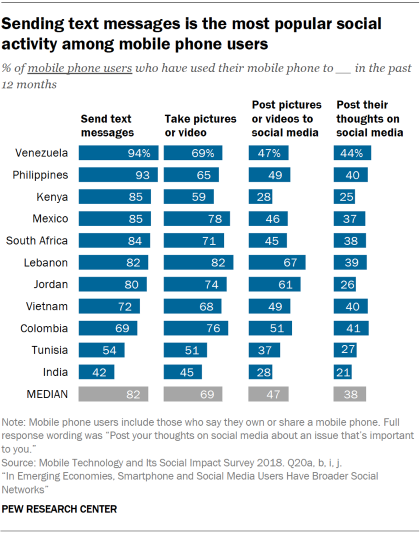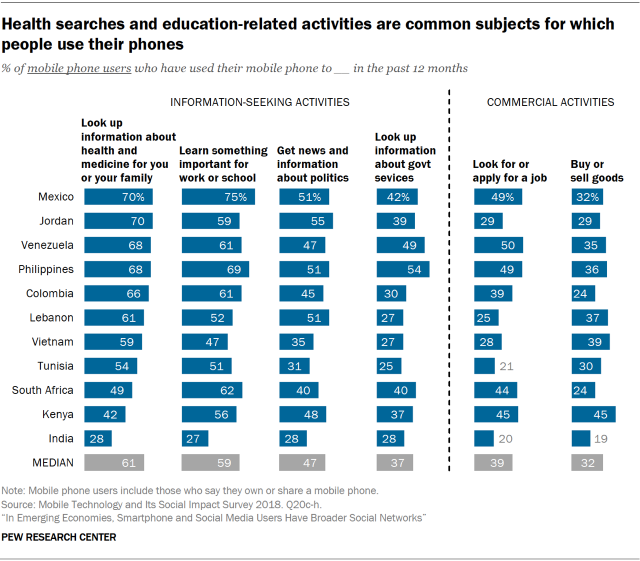
The survey asked mobile phone users about 10 activities they might do on their mobile phones. First, it included four activities that may be social in nature, including: sending text messages, taking pictures or video, posting pictures or videos to social media, and posting thoughts on social media. Second, it asked people whether they have used their phones for four types of information-seeking behaviors: to look up information about health and medicine, to look up information about government services, to learn something important for work or school, or to get news and information about politics. And third, it asked people about two types of commercial activities: looking for or applying for a job and buying or selling goods.
In almost every country surveyed, sending text messages is the most popular activity, although in Colombia and India taking pictures or videos tops the list. In Lebanon, equal shares say they use their phones to send text messages or take pictures or video. A median of 82% of mobile phone users across all 11 countries say they have used their mobile phone to send texts within the last year, including around seven-in-ten or more in all but Tunisia and India. Venezuelans used their phones to text most frequently – 94% of mobile phone users sent texts within the past year.

Sizable shares also report taking pictures or videos. In all countries except India, at least half of mobile phone users took photos or videos within the last year. Roughly three-in-ten or more in all the countries have also posted pictures or videos to social media, with people in Lebanon and Jordan standing out as the most likely to post on social media (67% and 61%, respectively). Use of social media and messaging apps in these two countries is particularly widespread.
Mobile phone users in India stand out for their low levels of participation in any of the social activities. Fewer than half have taken pictures or video or have sent text messages, and only about two-in-ten have posted their thoughts on social media. Mobile phone ownership is second lowest in India among the 11 countries surveyed, and only 32% of mobile phone owners have a smartphone – the lowest rate among all countries surveyed.
On Instagram, I just post pictures, like when I’m with my friends, you take a pic, and I post on Instagram. Then on WhatsApp, I communicate with the important people like my mum.Woman, 18, Kenya
Even when considering only mobile phone users who use social media and messaging apps, those with more education are more likely to post on social media. Take mobile phone and social media users in Lebanon as an example: 51% of those with more education posted on social media while 32% of those with less education did the same – a difference of 19 percentage points.

Among information-seeking and commercial activities, more users of mobile phones look up health information on their phones – a median of about six-in-ten did so over the past year. For example, seven-in-ten Mexicans and Jordanians have looked up information about health. Mobile phone users are similarly likely to have learned something for work or school on their phones. A median of 59% say they did so, with Mexicans standing out for the relatively high share (75%) who say they used their phones to look up something for work or school over the past year. Across most countries, fewer people have used their phones over the past year to get news and information about politics (a median of 47%) or to look up information about government services (a median of 37%). Notably, Indians are similarly unlikely to look up any type of information, with no more than 28% having looked up or searched for information on any of these topics.
As with social activities, those with more education or who are younger tend to be more likely to look up any type of information. Men tend to be more likely to look up information about government services or to use their phones to obtain political news or information. On the other hand, gender’s impact on obtaining health information is less clear: Women are more likely than men to do so in Lebanon and Jordan, while men are more likely to look for such information in India, South Africa and Kenya. In all other countries, there is no difference between how commonly men and women look up health information.
Commercial activities are less commonly pursued. A median of about four-in-ten have looked for or applied for jobs on their phone, and a median of roughly one-third have purchased or sold goods on their mobile phone. Only in Jordan and Kenya have equal shares done both activities. In most countries, men are more likely than women to have participated in these commercial activities.
As a farmer, I can market my products [on my mobile phone] and people from different places can get to know what I sell and at what amount.Woman, 25, Kenya
In nearly all countries, those with smartphones are significantly more likely than those with only basic or feature phones to participate in all activities. Notably, those with smartphones are more likely to text or take photos or videos than those with basic phones in all countries. Taking Tunisians as an example, three-quarters of smartphone users texted compared with about a third of basic phone users. And in Vietnam, 91% of those with smartphones took photos or videos, while only 17% of those with basic phones did the same.
Smartphone users are also more likely to participate in commercial activities. As an example, 19% of Venezuelan feature phone users have bought or sold goods on their phone, while 49% of smartphone users did the same. Smartphone and feature phone users also differ in most countries when it comes to posting on social media and all information-seeking activities.




